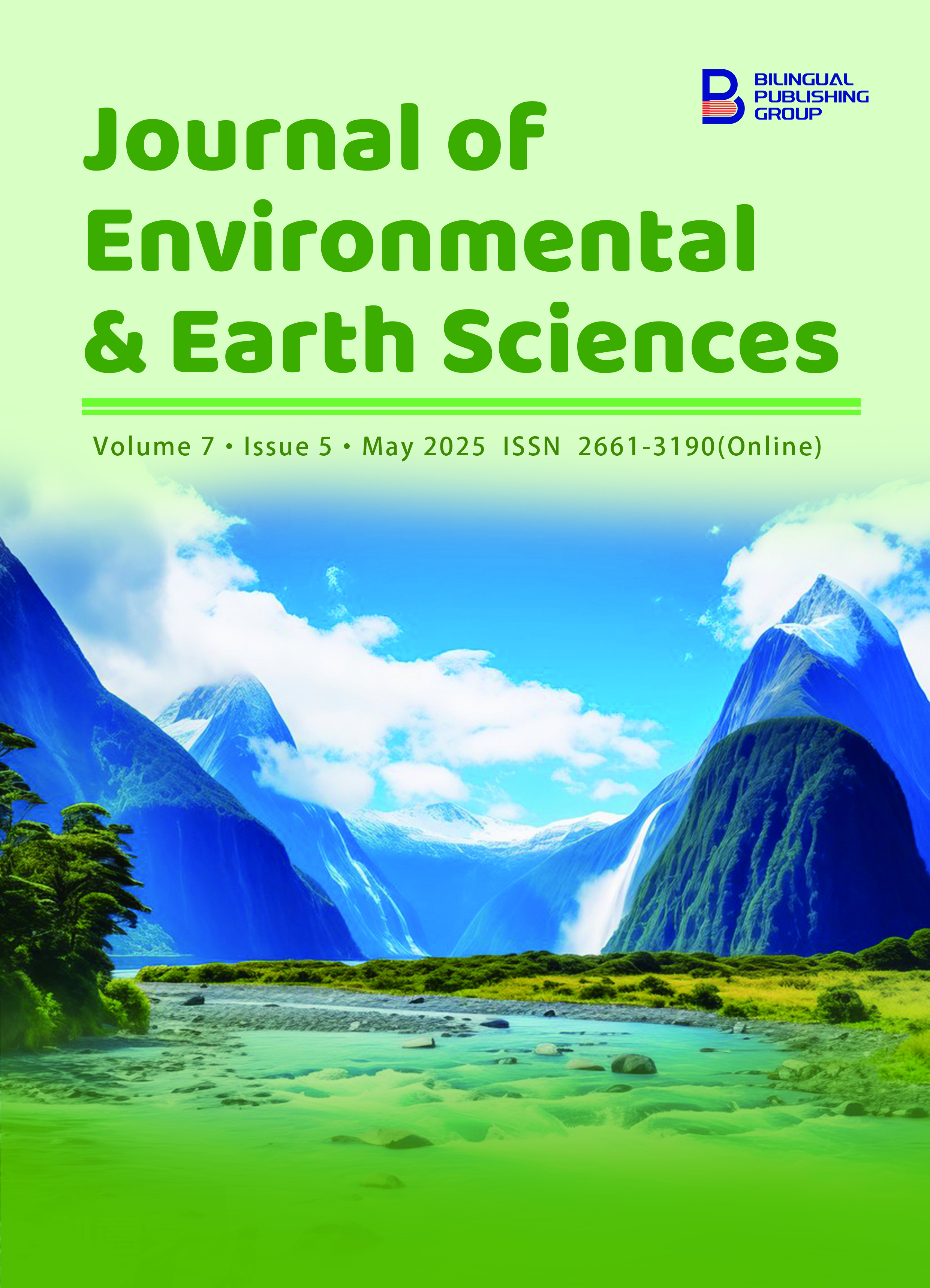
Role of Ochrobactrum Bacteria and Organic Matter in Plant Growth and the Content of N, P, and K Under Soil Salinity Stress
DOI:
https://doi.org/10.30564/jees.v7i5.8777Abstract
Organic matter increases biological activity within the root zone because it contains beneficial microbes that stimulate vital processes. This study aimed to determine the effect of Ochrobactrum anthropi added to the soil as a single or mixed solution with different concentrations of organic matter on the vegetative growth of the zinnia plant and its content of nutrients. The study was conducted with a randomized complete block design (RCBD) with three replications. The plant was grown in soil with a high salinity level of 8 ds m–1. Plant characteristics were estimated 30 and 60 days after planting the plant. The treatment with the addition of bio-inoculum produced the best results; within 30 days, there was a 56.89% increase in plant length; after 60 days, there was a 52.56% increase; additionally, there was a 52.56% increase in leaf count within 30 days; after 60 days, there was a 53.50% increase; and finally, there was an increase in flower count. For plants after 60 days, it reached 3.66%. With the addition of bio-inoculum to soil at a level of 3 gm kg–1 of organic matter, the mixing treatment achieved the highest dry weight, 29.86%. The addition of bio-inoculum resulted in the largest and most significant increase in chlorophyll content in leaves, reaching 18.76%. In the mixing addition of the biological inoculum treatment, the organic content of the plant showed an increase in nitrogen (14.38%), phosphorus (21.18%), and potassium (39.75%) at 2 and 3 gm kg–1 organic matter, respectively.
Keywords:
Ochrobactrum anthropi; Organic Matter; Salt Stress; Zinnia elegansReferences
[1] International Atomic Energy Agency, 1995. Management strategies to utilize salt affected soils. IAEA-TECDOC-814 July 1995, Version1.
[2] Bhardwaj, D., Ansari, M.W., Sahoo, R.K., et al., 2014. Biofertilizers function as key player in sustainable agriculture by improving soil fertility, plant tolerance and crop productivity. Microbial Cell Factories. 13, 1–10.
[3] Steinshamn, H., Thuen, E., Bleken, M.A., et al., 2004. Utilization of nitrogen (N) and phosphorus (P) in an organic dairy farming system in Norway. Agriculture, Ecosystems & Environment. 104(3), 509–522.
[4] Tilman, D., Gassman, K.G., Matson, P.A. et al., 2002. Agricultural sustainability and intensive production practices. Nature. 418(6898), 671–677.
[5] Wang, J., Sun, X., Du, L., et al., 2024. Appropriate fertilization increases carbon and nitrogen sequestration and economic benefit for straw-incorporated upland farming. Geoderma. 441, 116743.
[6] Hamid, M.Q., 2025. Mycorrhiza and Trichoderma fungi role in improving soil physical properties planted with maize (Zea mays L.). SABRAO Journal of Breeding and Genetics. 57(1), 260–269.
[7] Masotti, F., Garavaglia, B.S., Gottig, N., et al., 2023. Bioremediation of the herbicide glyphosate in polluted soils by plant-associated microbes. Current Opinion in Microbiology. 73, 102290.
[8] An, D., Danhorn, T., Fuqua, C., et al., 2006. Quorum sensing and motility mediate interactions between Pseudomonas aeruginosa and Agrobacterium tumefaciens in biofilm cocultures. Proceedings of the National Academy of Sciences of the United States of America. 103(10), 3828–3833.
[9] Chakraborty, U., Chakraborty, B.N., Basnet, M., et al., 2009. Evaluation of Ochrobactrum anthropi TRS‐2 and its talc based formulation for enhancement of growth of tea plants and management of brown root rot disease. Journal of Applied Microbiology. 107(2), 625–634.
[10] Imran, A., Saadalla, M.J.A., Khan, S.-U., et al., 2014. Ochrobactrum sp. Pv2Z2 exhibits multiple traits of plant growth promotion, biodegradation and N-acyl-homoserine-lactone quorum sensing. Annals of Microbiology. 64, 1797–1806.
[11] Tejada, M., Garcia, C., Gonzalez, J.L., et al., 2006. Use of organic amendment as a strategy for saline soil remediation: Influence on the physical, chemical and biological properties of soil. Soil Biology and Biochemistry. 38(6), 1413–1421.
[12] Cha-um, S., Kirdmanee, C.., 2011. Remediation of salt-affected soil by the addition of organic matter: An investigation into improving glutinous rice productivity. Scientia Agricola. 68, 406–410.
[13] Lakhdar, A., Scelza, R., Scotti, R., et al., 2010. The effect of compost and sewage sludge on soil biologic activities in salt affected soil. Journal of Soil Science and Plant Nutrition. 10(1), 40–47.
[14] Al-Taweel, L., Abo-Tabikh, M., 2019. Urea and ammonium sulfate fertilizers and humic acid effect on urease enzyme activity in and out the rhizosphere of Zea mays L. crop. Plant Archives. 19(1), 1905–1914.
[15] Epstein, E., 1980. Responses of plants to saline environments. In: Rains, D.W., Valentine, R.C., Hollaender, A. (eds.). Genetic Engineering of Osmoregulation: Impact on Plant Productivity for Food, Chemicals, and Energy. Springer: Boston, MA, USA. pp. 7–21.
[16] Tarchitzky, J., Chen, Y., 2002. Rheology of sodium‐montmorillonite suspensions: Effects of humic substances and pH. Soil Science Society of America Journal. 66(2), 406–412.
[17] Nawaz, K., Hussain, K., Majeed, A., et al., 2010. Fatality of salt stress to plants: Morphological, physiological and biochemical aspects. African Journal of Biotechnology. 9(34), 5475–5480.
[18] Paudel, A., 2020. Propagation of Two Utah Native Plants: Ceanothus Velutinus and Cercocarpus Montanus [Master’s thesis]. Logan, UT, USA: Utah State University. p. iii-100.
[19] Page, A.L., Miller, R.H., Kenney, D.R., 1982. Methods of soil analysis. Part 2. Agronomy No. 9, Madison, USA.
[20] Goodwin, T.W., 1965. Chemistry and Biochemistry of Plant Pigments, 2nd ed. Academic Press: London, UK. pp. xiii + 583.
[21] Misra, A., Srivastava, A.K., Srivastava, N.K., et al., 2010. Se-acquisition and reactive oxygen species role in growth, photosynthesis, photosynthetic pigments, and biochemical changes in essential oil (s) monoterpene of Geranium (Pelargonium graveolens L. Her.’ex. Ait.). American-Eurasian Journal of Sustainable Agriculture. 4(1), 39–46.
[22] Atiyeh, R., Lee, S., Edwards, C.A., et al., 2002. The influence of humic acids derived from earthworm-processed organic wastes on plant growth. Bioresource Technology. 84(1), 7–14.
[23] Aisha, A.H., Fatma, A., Rizk, A.M., et al., 2007. Onion plant growth, bulbs yield and its physical and chemical properties as affected by organic and natural fertilization. Research Journal of Agriculture and Biological Sciences. 3(5), 380–388.
[24] Canellas, L.P., Olivares, F.L., Aguiar, N.O., et al., 2015. Humic and fulvic acids as biostimulants in horticulture. Scientia Horticulturae. 196, 15–27.
[25] Schenck zu Schweinsberg‐Mickan, M., Müller, T., 2009. Impact of effective microorganisms and other biofertilizers on soil microbial characteristics, organic‐matter decomposition, and plant growth. Journal of Plant Nutrition and Soil Science. 172(5), 704–712.
[26] Wang, Q., Wang, K., Cui, Z., et al., 2013. Effect of humic acid on tubers secondary metabolism and growth physiological property of Pinellia pedatisecta under high temperature stress. Acta Botanica Boreali-Occidentalia Sinica. 33(9), 1845–1850.
[27] Nikipelova, O., Pyliak, N., Yarochevsky, V., et al., 2024. Study of the influence of different organic fertilizers on soil agrochemical parameters in hazelnut plantations in Ukrainian Southern Steppe. Agronomy Research. 22(3), 1241–1253.
[28] Ali, Z.A., Hassan, D.F., Mohammed, R.J., 2021. Effect of irrigation level and nitrogen fertilizer on water consumption and faba bean growth. IOP Conference Series: Earth and Environmental Science. 722, 012043.
Downloads
How to Cite
Issue
Article Type
License
Copyright © 2025 Huda Krebit Hundi, Mustafa Qais Hamid, Ali Abdul Majeed Noori

This is an open access article under the Creative Commons Attribution-NonCommercial 4.0 International (CC BY-NC 4.0) License.







 Huda Krebit Hundi
Huda Krebit Hundi






